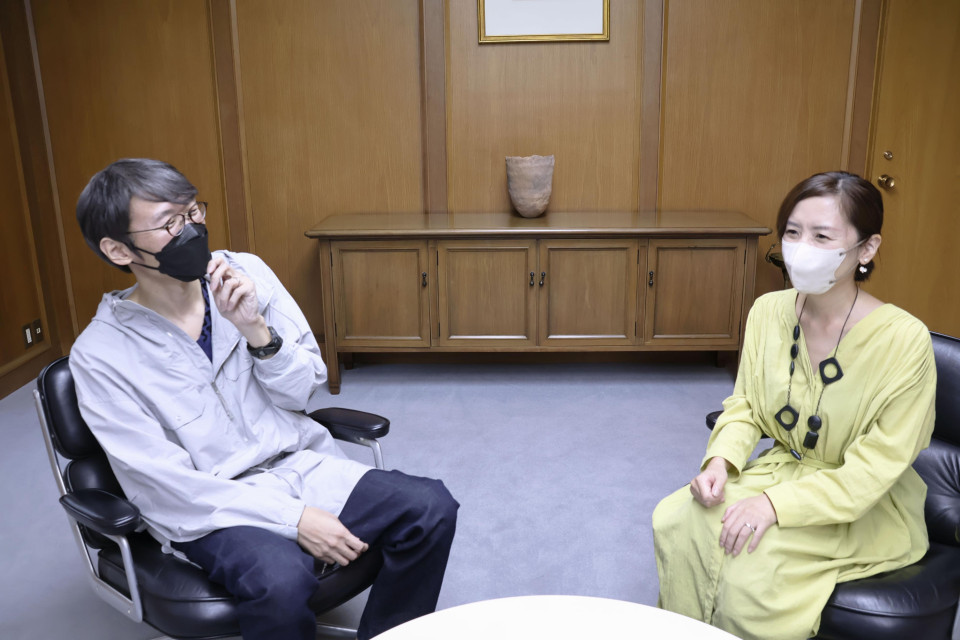Spending an adult life without detecting disabilities is not uncommon and can pose varied difficulties.
And a Japanese couple offers clues for how to approach one such case and a hint at a remedy as well from the perspective of people who are living the experience.
Manga artists Eri Nanato, 43 and Satoshi Kameyama, 41, have brought the issue of adult developmental disorders to the fore via the pages of a manga series that conveys the challenges they face in real life.

Eri Nanato (R) and her husband Satoshi Kameyama, authors of the manga “My Wife is Developmentally Disabled,” in Tokyo on Oct. 18, 2023. (Kyodo)
The series is titled “My Wife is Developmentally Disabled” for publication in a monthly magazine.
Eri was diagnosed with a developmental disorder when she was in her mid-30s. She met Satoshi, who was also an aspiring cartoonist, and had been married one year when she got the news. Before this, the couple’s everyday life had been “like a war” with fights and quarrels lasting until dawn almost daily, she recalled.
Identified in children in many cases, developmental disorders can manifest in conditions such as autism spectrum disorder, attention-deficit/hyperactivity disorder, learning disorders and intellectual disability, among others.
Diagnosis of developmental disorders in adulthood is sometimes the result of the sufferer showing mild symptoms or having developed ways to compensate for the condition. Some adults simply develop symptoms later in life and there exists cases where minor disabilities remained undetected until adulthood.
Eri would drift off during conversations as her attention turned elsewhere, and she would often not remember anything Satoshi had said. Half on a hunch, she visited a doctor and notified her husband of the examination results in a text message the same day.
“I found out I have a developmental disorder. I’m sorry,” she texted him.
Eri believed an apology was in order because she felt guilty that Satoshi had the misfortune to marry someone with a condition like hers. To encourage and give Eri strength, Satoshi sent her a smiling emoji in reply.
Despite a diagnosis being a potential sign of progress, that day was when the balance in their relationship edged in an unhealthy direction.
“We used to argue logically on equal footing, at least, but I then began to feel more or less that I was the normal one and therefore always correct,” Satoshi said.
This imbalance played out in other parts of their daily lives. Eri said she even tried to take her own life and would stop rolling over in bed, for instance, for fear of waking her husband.
Feeling anxious himself, Satoshi was unable to focus on work or married life and became addicted to online gaming, spending as much as 2 million yen ($13,300) in six months on the habit at one point.
Only when each of them reflected on themselves, based on advice they received from a psychiatrist, did they begin to understand their shared suffering.
The manga series began in Monthly Comic Bunch, published by Shinchosha Publishing Co., in 2020. The story is about the daily life of Chika, a developmentally disabled woman working at an apparel shop, and her husband Satoru, an assistant to a manga artist.
A scene from “My Wife is Developmentally Disabled” (Image courtesy of Shinchosha Publishing Co.)(Kyodo)
Although cheerful and vivacious with great sales numbers, Chika has trouble doing two things at once. For example, if a customer asks her a question while she is folding merchandise, she will forget what she was doing and cause frustration among her coworkers.
Satoru is baffled as to why she gets flustered when she cannot carry out her household chores in an exact order — another symptom of her condition. To find solutions, the couple speaks about ways they can devise ways to overcome their everyday challenges.
One tactic is to put up a “no disturbance sign” when Satoru needs to concentrate on his manga work. When Chika sees it, she knows to only communicate via text message.
The story is fiction, though based on Eri’s experience at an apparel shop as well as what the couple has heard from other developmentally disabled people they became acquainted with on social media.
“I tend to mull things over in my mind, while my wife can make quick decisions,” Satoshi said when speaking about the themes of the series — a product of the couple’s collaborative effort, with their personality styles complementing each other’s.
A scene from “My Wife is Developmentally Disabled” (Image courtesy of Shinchosha Publishing Co.)(Kyodo)
Thankfulness is what Satoshi and Eri wish to express most through the work. Whether the characters sometimes have miscommunications or blowups, they still arrive at a point of “mutual respect.”
“Each person with a developmental disorder is unique…Some find life easier, given the right environment and people,” Satoshi said.
There is a line spoken by Satoru in the manga series that Satoshi said symbolizes his relationship with his wife in real life.
“It goes, ‘Chika is indeed odd but I think odd is alright. I’m not perfect in any way, either. It’s mutual’,” Satoshi said.
Related coverage:
FEATURE: French artisan’s bright idea keeps passion for Suifu lanterns burning
FEATURE: “Dreamnight” program enables disabled kids to enjoy zoo visits
FEATURE: Classroom avatar creating constructive conflict at small Japanese schools
